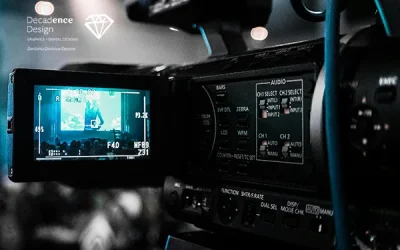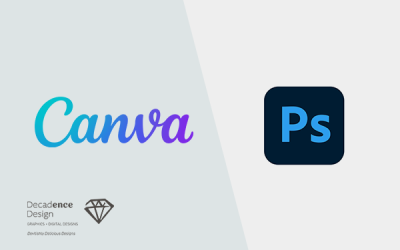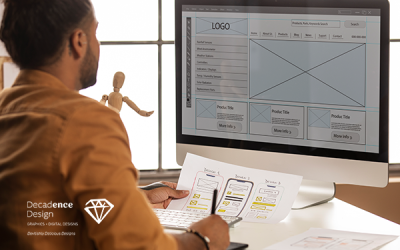Are you looking to create a brochure design that stands out from the competition? Do you need help developing an effective design structure and choosing the right colours, fonts, and images? If so, then this article is for you. We’ll be discussing 10 essential steps to perfect brochure design – covering everything from research and development of a structure to proofreading, printing and distributing your final product. So, if you want to learn how to create a brochure that will engage your target audience and make sure it stands out from the crowd, keep reading! And don’t forget- if you need any help along the way, contact Decadence Design for professional brochure design services.
1. Define your goals and objectives
Creating a brochure design that stands out from the competition requires more than just picking an eye-catching font and color scheme. To ensure your design achieves its desired goal, it is important to set clear objectives before diving into the creative process. Here are five steps to help you define your goals and objectives for your brochure design project:
- Determine who will be the main target audience for the brochure design: Identifying the primary demographic of people you want to reach with your brochure is essential in creating a successful piece of communication. Consider factors such as age, gender, location, interests and level of education when determining who you want to target with your design.
- Identify the purpose of the brochure design: Is this a promotional piece meant to increase sales? Are you trying to explain a complex product or service? Or are you aiming to create an emotional connection with readers? Knowing what kind of message you want to communicate will help guide all other aspects of your project.
- Set measurable goals for the brochure design project: Once you have identified who you are targeting and what kind of message you want to convey, decide on some concrete metrics that will measure success. This could include website visits, newsletter signups or sales conversions—whatever makes sense for your business objective.
- Decide on your budget and timeline for completing the project: Having an idea of how much money and time you can allocate towards this project can help inform decisions around elements like materials used, production methods and timeline expectations throughout each step in the process.
- Create a list of deliverables to guide your progress: Assemble a comprehensive list of tasks that need to be completed during each phase of designing, producing and distributing your brochures—from research through printing/distribution – so that everyone involved in the project is aware of their responsibilities at any given point in time. This helps keep everyone focused on their part in making sure everything runs smoothly from start to finish!
2. Research your audience
Researching your audience is a critical step in any brochure design project. Knowing your target demographic will help you create a design that speaks to their needs, wants, values, and preferences. It can also help you stay ahead of the competition by understanding their approach to the same market.
Start by gathering as much information about your target demographic as possible. This could include age range, gender, income level, geographic location, buying habits, and more. You’ll want to know what makes them tick and how they interact with media and advertising. Once you have an idea of who you’re designing for, it’s time to delve into trends in design and typography that will make your brochure stand out from the competition. Look for current fonts that are on-trend but still professional-looking; colours that evoke emotions; images that are eye-catching yet relevant; and layouts that are clean and organized but still aesthetically pleasing.
Once you have narrowed down some ideas for design elements, it’s time to get feedback from peers or professionals. Conduct surveys or focus groups with potential customers so they can give valuable feedback on different designs before committing to one style or colour scheme. This feedback can be invaluable in helping fine tune your brochure design so it appeals directly to your target audience.
Finally, don’t forget to look at what the competition is doing – analyse their approach to the same market and use this knowledge to create something unique yet successful for your business. By researching your audience thoroughly before creating a brochure design, you can be sure that it will engage them effectively while standing out from the crowd!
3. Develop a structure for your brochure design
Developing a structured brochure design is key to communicating your message to the desired audience. Start by determining how many pages are required and arrange the information into an organized and concise format with a logical visual hierarchy. This will help readers find what they are looking for quickly and easily, using elements such as font size variations, white space between text, and minimal distractions from the main idea.
Ensure that each element included serves a purpose and adds value to the overall concept or theme of the brochure design. Visuals should not be overused as this could lead to confusion and overwhelm readers. It is important that all aspects of the design remain balanced across all pages; none should look too crowded or sparse. If visuals are implemented, make sure they don’t overpower any logos or text—they should always complement rather than detract from it.
By following these steps you can create something that will engage readers while distinguishing itself from competitors’ designs. The ultimate goal is for readers to understand how each part works together towards achieving success—so keep it simple yet effective!
4. Create a layout that engages your audience
For an effective brochure design, it’s essential to craft a layout that will engage your intended readership. You should arrange the content and images in a way that is logical and visually appealing; each item should serve its own purpose. It’s important not to overcrowd the page with too many elements as this can lead to confusion. Additionally, be mindful when selecting fonts – they should remain legible while adding character to the design. Moreover, you can supplement your design with relevant visuals for added impact. Make sure these are appropriate for various print products such as posters or postcards, as well as digital platforms such as webpages or social media accounts. When using text and images together, be sure to leave plenty of white space between them so that readers won’t struggle with readability. Through careful planning and consideration of all these details, you can create an attractive brochure layout that will draw attention from your target audience!
5. Choose the right fonts, colors, and images
Selecting the right fonts, colors, and images for your brochure design can be a challenge. To help you create an effective and memorable layout, here are some tips to keep in mind:
When it comes to font selection, make sure that the typeface is legible while still adding character. You may need to adjust the sizes of different fonts depending on where they are being used in order to maintain legibility. Also ensure that all fonts used are consistent throughout the design.
Colours should evoke emotion as well as match with your brand identity and overall aesthetic of your message. Test out any colour combinations before printing them in bulk as some colours may not print accurately.
Visuals help effectively communicate a message more than text alone ever could; therefore choose relevant visuals carefully rather than using them solely for decoration purposes only. All visuals should be complementary with other elements on the page such as logos or text – balance is key! Match all visuals with the theme of your brochure so they stand out from competitor designs.
Finally, make sure all pieces of your brochure design fit together harmoniously into one unified look by matching elements (font size/type/colour) accordingly and giving each element its own space so that nothing overwhelms each other visually – remember to ask yourself if every element adds value and serves its purpose!
6. Focus on the copywriting
Writing compelling copy for your brochure design is essential to ensure that it stands out from the rest and is engaging for the target audience. A great headline can be the difference between a brochure that will be read or one that will be quickly discarded, so it’s important to craft a catchy yet informative title.
The language you use in your brochure should be easy to understand and conveys the desired message clearly. Your copy should also focus on the main message of your brochure, which should remain consistent throughout all other elements of the design. It’s essential to organize your copy in a logical manner, breaking content into sections with headlines and subheadings, bullet points where appropriate, and including plenty of white space. Additionally, including keywords related to your topic can help boost SEO rankings and draw more attention to your brochure design.
Finally, make sure you proofread all text multiple times before printing out any copies of your brochure design. Check spelling and grammar thoroughly as mistakes can appear unprofessional and distract from the overall message you are trying to convey. You may even want to ask colleagues or professionals in the field for feedback on how well they think it communicates its purpose before sending off for printing.
By following these steps when crafting copywriting for your brochure design, you can create an effective piece of communication that engages with its intended audience while remaining true to its purpose and brand identity.
7. Follow the rules of print design
Creating a brochure design is more than just slapping together some visuals and text. To get the most out of your brochure, you need to understand the rules of print design and follow best practices for creating printed materials. Print design is different from web design in that it involves physical constraints like paper stock, size requirements, bleed space, color modes, and more.
When it comes to paper stock, there are many options available including glossy, matte, cardstock, and recycled paper. Each one will affect the way your brochure looks and feels when held by customers or prospects. Additionally, you need to be aware of size requirements; for example in Singapore A4 is the standard size for printed materials. It’s also important to leave room for bleed space – an extra 3mm of space around each edge of the page – so that nothing important gets cut off when printing.
In terms of colour mode for print materials, you should use CMYK (Cyan-Magenta-Yellow-Black) as this is what printers use to create colours on a page. On top of this you should also consider using spot colours which are special inks used to create vivid colours that can’t be created with CMYK or pantone inks alone. Spot colours can help your brochure stand out from other printed materials but should be used sparingly due to cost considerations.
Finally, before printing your brochure make sure to run a proofreading process over all content multiple times and review all pages individually on screen before sending them off to press. By understanding the basics of print design and following best practices throughout the entire process you can ensure that your brochure looks great when printed and stands out from the competition.
8. Make use of white space
White space can be a powerful asset in brochure design. When used correctly, it can draw attention to certain elements and add to the overall aesthetic of the project. Additionally, by strategically placing white space around key features, readers are given visual cues that guide them through your content in an organized manner.
To ensure successful use of white space in your design, it’s important to find a balance between graphical elements and text. Too much of either could lead to an empty feeling or overwhelm the reader with too much information at once. Additionally, larger font sizes for headings will help break up long chunks of text and make your brochure easier on the eyes.
When adding white space around graphical elements or sections of text, focus on areas where readers are likely to pause or look for more information. This will create visual cues that will direct their attention without being too obvious or distracting from the overall design aesthetic. Additionally, keeping margins consistent throughout your brochure design keeps all elements flowing together harmoniously without overwhelming readers with too much data at once.
By taking these tips into consideration when designing a brochure, you can create an engaging piece that stands out from the competition and resonates with its target audience. White space should be used strategically but sparingly – done correctly it can have a huge impact on how effective your piece is!
9. Get feedback from peers and professionals
In this section, we will focus on the importance of getting feedback from peers and professionals when designing a brochure. Seeking out opinions from those who are familiar with the topic can help you refine your design, while seeking reviews from experienced professionals in your industry can ensure that your work is at its highest quality. Additionally, gathering feedback from both experienced and novice designers may give you an insight into how the average person perceives your design.
Using focus groups or surveys to get feedback from potential customers can also help you understand how effective your design is and make any necessary adjustments. This allows you to test out different versions of your design before it goes to print, ensuring that it resonates with its intended audience and stands out in a crowded marketplace.
Having an open dialogue between yourself and other stakeholders during the development process is key to creating a successful brochure design. This means taking time to listen to what others have to say about it, even if their ideas differ from yours. By involving different minds in the creative process, you can build a solid foundation for creating a unique brochure that accurately reflects your brand identity and message.
Finally, don’t forget that collaboration doesn’t end once the design is completed; it’s essential to continue gathering feedback after printing as well. Ask customers what they think of your designs and see if there are any areas where you can improve them further down the line. With this kind of ongoing feedback loop in place, you’re sure to create eye-catching brochures that leave lasting impressions on all who see them!
10. Proofread, print, and distribute the brochure design
When you have finished designing your brochure, you should take time to thoroughly read through it and make sure all the information is accurate and current. It’s also important to check that any multiple versions (digital or printed) are consistent with each other. Investing in professional printing services which provide optimal results for each medium will add a sense of professionalism to your design.
Once you have distributed your brochure, it is essential to track its performance and receive feedback from customers or peers who have seen or used it. This way, you can gain insight into what works well and what could be improved on for future designs. By carefully taking these steps, you can guarantee that your message is delivered effectively and stands out from the competition.
Creating a successful brochure involves dedication and attention to detail during every step of the process – from establishing goals and objectives all the way through proofreading, printing, and distribution. Doing so will give you something special that helps promote whatever product or idea you want to communicate.





